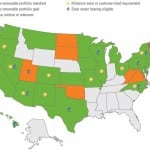Renewable energy is not the future; it is the present. Nearly half the new electricity generation in the U.S. this year will come from renewable sources. And after last year’s signing of the Infrastructure Investment and Jobs Act (IIJA)—plus the extension of income tax credits related to renewables—the proliferation of sustainable sources, technology, and infrastructure is only going to accelerate as more federal dollars are deployed.
COMMENTARY
Financing and Risk Management Instruments
For example, within the IIJA, more than $73 billion has been earmarked for clean energy transmission. Another $6 billion is targeted for battery technology and production, along with $7.5 billion for electric vehicle (EV) infrastructure. To accommodate this level of investment, financing and risk management instruments must be in place to enable these projects to progress forward. However, are renewable developers and operators ready to respond?
With a rush to bring new projects online, developers, renewable energy contractors, energy storage companies, and others must approach this current “building boom” strategically. Enter surety bonds.
When developers typically post security to third parties to meet regulatory and contractual requirements—including project interconnection, power purchase, supply agreements/guarantees, etc.—they often use cash or letters of credit. Surety bonds (also known as performance bonds) are a stronger option to increase development capacity and minimize financial exposure.
Why? Posting cash directly affects a developer’s working capital, while letters of credit also require some cash collateral and increased debt obligations. As a contingent form of liability, surety bonds do not have these negative impacts. However, while a widely accepted instrument for construction, familiarity with surety in the renewable sector remains nascent.
Understanding Surety’s Advantages
To properly leverage surety, developers must understand the clear advantages. Whether directly resulting from the IIJA or overall expansion of renewable energy growth, the following are examples of where these types of bonds can be applied.
Solar Module Procurement. Many solar developers are currently faced with panel availability challenges, as suppliers seek assurances for the large module purchase orders that will account for a high allocation of their total production. Larger suppliers of panels have been receptive to the use of surety guarantees as an alternative to a cash security deposit, as a way of navigating this dynamic.

Energy Storage. Battery storage is a rapidly emerging component of energy supply, and some project developers require completion assurances from parties building battery energy storage system, or BESS, facilities. While the IIJA aims to catalyze domestic production, projects in the meantime will still rely on batteries procured from outside the U.S.
This challenge translates to developers requiring guarantees to adhere to build schedules and delivery timelines in the face of global supply chain issues. In addition, start-ups entering the space because of the IIJA will likely face these same security requirements.
Decommissioning. Many public sector jurisdictions require a form of financial assurance before removing installed power generation equipment. Given the rapid growth of utility scale and community solar projects throughout the U.S., towns, counties, and cities are re-assessing their security policies. Surety bonds can be one option, especially in cases where the project owner holds the renewable asset through to useful end date, having to forego cash or take on debt for decades.
Power Purchase Agreements. Utilities and large companies, referred to as “off-takers,” contract with power producers to purchase power at a specified rate. These contracts—also known as power purchase agreements, or PPAs—require a form of security as a backstop if the facility does not generate power as promised. With required collateral often exceeding seven figures, utilizing a surety bond can be a highly favorable developer option.
Interconnection Agreements. Most renewable energy projects in the U.S. are connected to traditional utilities via an interconnection agreement. With the IIJA, thousands of miles of new transmission lines are planned and will facilitate the growth of renewable energy assets. To ensure utilities do not take on unnecessary risk despite receiving funds for these interconnections, financial guarantees are required to ensure expenditures associated with connecting new solar and wind farms to their grid are fully reimbursed. In some instances, utilities will accept surety as that guarantee.
Electric Vehicle Infrastructure. To create a national EV charging network, the IIJA supports the accelerated deployment of chargers in residential and commercial buildings, and parking systems, along with roadside options. Accordingly, state and local governments, and utilities, are starting to post performance bond requirements for installation projects.
As utilities, developers, and other players in the renewable energy sector evaluate prospective work and their project pipeline, they must have the financial tools at the ready to secure new projects. Collaborating with an experienced surety broker, taking the time to set up a renewable energy–specific surety bond facility, and educating partners and off-takers on their viability will pay off with reduced financial exposure, freed-up capital, and greater security for all parties. ■
—Karl Choltus is National Surety Practice Leader for Brown & Brown, an American provider of insurance, reinsurance products, and federal programs services to general business, corporate, governmental, quasi-governmental, institutional, professional, trade association, and individual clients.











